(MENAFN- ProactiveInvestors)
Near the beginning of every year we update and publish what can safely be called our most popular piece: the Periodic Table of Commodities Returns.
Below are the latest year-end results which show the historical performance of commodities from best to worst. A larger high-definition version of the table is available for download.
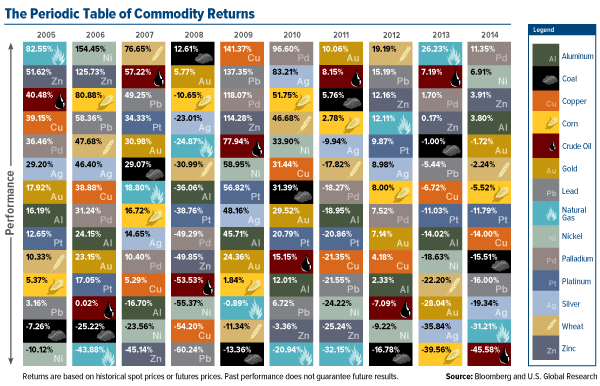
click to enlarge
Last year we experienced one of the biggest commodity corrections in recent memory—the biggest since 1986 in fact—and we’re happy to put it in our rearview mirrors.
Base Metals Boasted Mettle
Although it came in second overall right behind palladium nickel was the real standout of 2014. With a shabby 10-year annualized track record of -1.8 percent the metal gained nearly 7 percent on the back of supply scares after Indonesia the world’s largest producer unexpectedly banned all nickel exports last January to meet domestic demand. By May the metal had rocketed up more than 50 percent before cooling to 37 percent in July when it was then the best-performing commodity.
Aluminum also managed to beat its 10-year annualized performance by close to 3 percentage points owing to global production cuts and increased industrial usage of the metal in automobiles and aeronautics. The 2015 F-150 for example is the first mass-produced truck in its class to feature an aluminum-alloy body. Because of these developments Texas-based aluminum-producer which we own in our Global Resources Fund (PSPFX)enjoyed its best year since 2008 delivering 50 percent.
Precious Metals Pressured
Palladium 2014’s top commodity performed relatively according to script. For the year it was up 11.35 percent compared to its 10-year annualized returns of 14 percent. Much like nickel palladium was spurred by extenuating circumstances. Between January and June a labor strike in South Africa the world’s second-largest producer of the metal following Russia halted production which depleted reserves and sent palladium to a three-year high of $850 an ounce.
Although nickel doesn’t have an exchange-traded fund (ETF) we manage to capture growth through a palladium ETF.
The South African labor strike however didn’t seem to help palladium’s sister metal which ended the year down 11.79 percent. To combat and find solutions to years’ worth of flat sales six South African producers launched the World Platinum Investment Councilin December. CEO Paul Wilson summed up the group’s mission:
To date the investment potential of has been largely overlooked. We believe that presenting the investment proposition to a wider range of investors will result in it rightfully being considered favorably as an investment.
Silver had its second straight down year falling 19 percent despite record sales of Silver Eagle coins. According to the U.S. Mint 44 million ounces were sold in 2014 outpacing Gold Eagle sales by 59 percent. The U.S. Mint’s stock of bullion completely dried up on Christmas Eve.
However silver mining also accelerated to record highs last year. This coupled with weak industrial use of silver in the first half of 2014 led to falling prices.
And then there’s gold which also fell (slightly) for the second consecutive year. As I’ve already reported even though the yellow metal dropped 1.72 it still remained a more reliable form of currency than any other globally excluding the U.S. dollar.
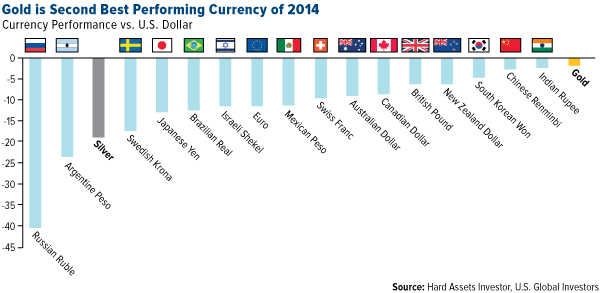
click to enlarge
Energy Feeling Sluggish
Besides crude oil the biggest loser was natural gas. A particularly brutal winter in late 2013 helped make it the top performer for that year. But even though the polar vortex—remember that—dragged frigid temperatures into the beginning of the new year natural gas couldn’t quite manage to ignite the flame in 2014 which turned out to be one of the warmest years on record.
Natural gas remains the worst-performing commodity for the 10-year period down 3.73 percent.
All three energy-related commodities—coal natural gas and crude oil—showed up in the bottom five their first time to do so since 2006.
Weighed down by crude oil which tanked 46 percent in 2014 the energy component of the S&P Commodities Index (GSCI) lost 44 percent for the year.
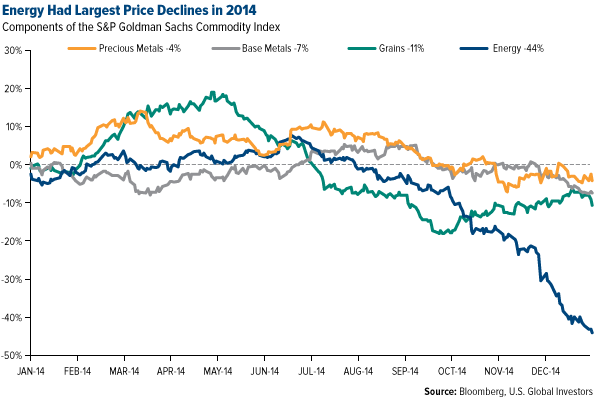
click to enlarge
By all accounts crude oil’s collapse was both unexpected and swift—and it looks as if the bottom has not yet been reached. recently reduced its six- and 12-month West Texas Intermediate (WTI) crude forecasts to $39 per barrel.
It’s disconcerting to recall that as recently as July Brent oil set a record for trading between $107 and $112 per barrel for 12 consecutive months. It now trades for less than half that at approximately $50 per barrel.
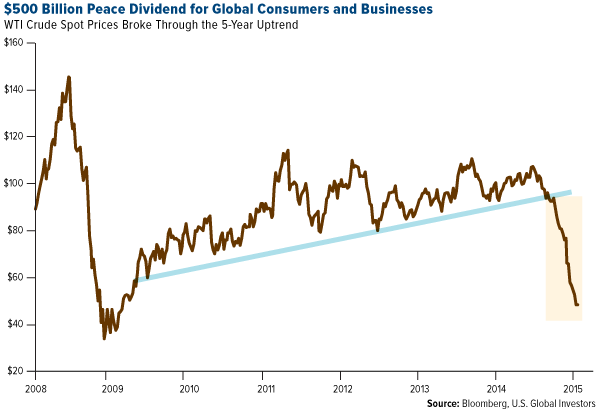
click to enlarge
The selloff is so extended now that crude’s weekly relative strength index (RSI) is at 8.5 which is even lower than its RSI during the 2008-2009 crisis.
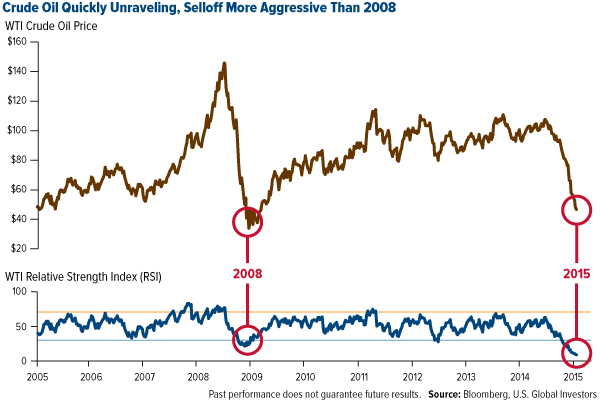
click to enlarge
Where’s the Global Demand
In response to unraveling crude prices several companies from the small caps to the majors announced they would be laying off workers in huge numbers. the world’s largest oilfield-services company will reportedly be letting go of 9000 of its workers or 7 percent of its workforce; Energy Canada’s largest will cut 1000 members of its staff and slashed $1 billion in capital spending.
Many more companies have had no other choice than to cut costs by halting exploration and production. The U.S. oil rig count saw its largest one-week drop in six years losing 74 this week alone. As disconcerting as all this might sound—especially the job losses—these decisions are necessary to rebalance supply and demand and stabilize prices.
After peaking at $10 per 1000 cubic feet in 2008 prices for natural gas—remember it’s the worst-performing commodity of the last 10 years—plummeted and never fully recovered which is why you see a gradually diminishing number of gas rigs in the chart below.
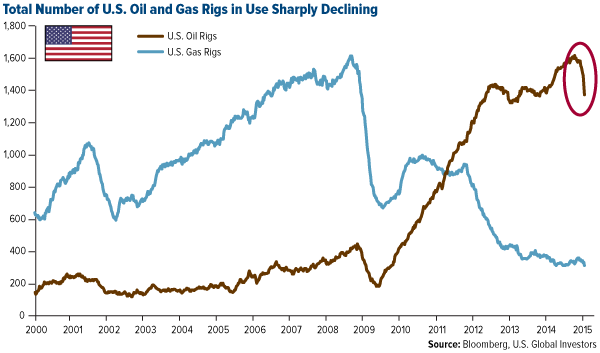
click to enlarge
When the shale oil revolution began in 2009 the number of rigs steeply ramped up adding approximately 200 new rigs each year. And not just any rigs but much more efficient technologically-advanced pieces of machinery capable of extracting crude from places that until now were inaccessible.
That’s what American ingenuity has given the world: cheap oil and cheap fuel. Speaking on CNBC this week Nobel Prize-winning economist Robert Shiller praised the U.S.’s drive and innovative spirit: “This country is proud of our oil technology and it’s been boosting our spirit our animal spirits.”
But just as the U.S. has provided the world with plentiful oil the rest of the global economy has cooled especially Europe choking demand.
“The global economy today is much larger than what it used to be” World Bank Chief Economist Kaushik Basu recently stated “so it’s a case of a larger train being pulled by a single engine the American one.”
Tough Times Don’t Last Forever
Speaking to Fox Business on Monday PSPFX portfolio manager Brian Hicks explained where we continue to see opportunity and value in this low-price environment:
Certainly the [oil] selloff is getting long in the tooth and we're actually becoming more and more constructive as [it] continues... These prices are not sustainable [and] not high enough to replace production going down a few years from now. We think the stocks look very attractive here and if you look at their performance to crude oil they've actually been outperforming since mid-December.
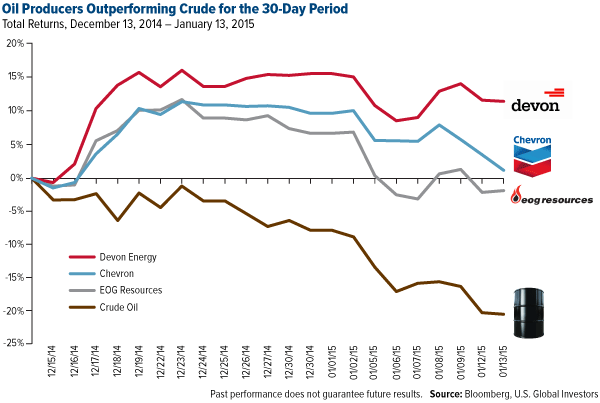
click to enlarge
Michael Waring CEO and Chief Investment Officer of Toronto-based Galileo Global Equity Advisors visited our office this week and reminded our team of the cyclical nature of the energy sector. We’ve been through similar downturns in crude oil Michael noted—in 1986 and 2008-2009 most recently.
“I’ve seen this movie so many times I already know the ending” Michael said suggesting that oil has tended to move back to its mean eventually.
The chart below shows the inverse relationship between crude and the dollar going back to 1984. The current standard deviation spread between the two is clearly widening to 1985 and 2008-2009 levels. But as strong as the dollar or as depressed as oil got both eventually reverted back to their means.
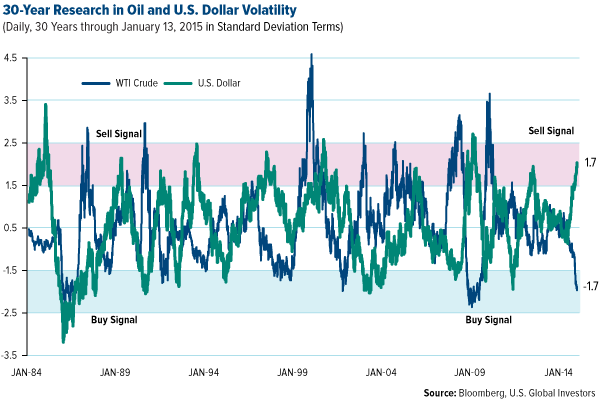
click to enlarge
For the past 30 years the 12-month rolling sigma or volatility for oil 70 percent of the time is ±30 percent; the dollar’s is ±9 percent. Today the odds are high that the dollar will correct and oil will rise. In 30 years this is the third-widest gap between oil falling and dollar rising. But if you look over the same 30 years you’ll see that oil has historically bottomed in February and subsequently rallied.
I cannot stress enough how greatly low gasoline prices have benefited consumers. They might also contribute to non-oil-services employment. According to BCA Research:
In the U.S. the decline in gasoline prices should boost household disposable incomes by around $150 billion this year with an additional $30 billion coming from lower heating bills [and] decreased airline fares... The money spent in turn will generate additional demand for goods and services. This will lead to faster employment growth translating into more income and spending.
Mark Your Calendars
- This Sunday and Monday I will be presenting at the 20th Anniversary Vancouver Resource Investment Conference 2015. I realize not everyone can travel to British Columbia on such short notice so I’ll be sure to inform you of the main takeaways from the conference.
Watch my preconference interview with Vanessa Collette host of Live. - On Wednesday January 21 we will be hosting our first webcast of the year “Bad News Is Good News: A Contrarian Case for Commodities.” The presenters include me Director of Research John Derrick and portfolio managers Brian Hicks and Ralph Aldis. Don’t miss out on this special opportunity to gain expert insight on where commodities might be headed this year!
You can register here. - On Wednesday February 18 we will be conducting our second webcast which will focus on China and Emerging Europe.
- And finally look out for our Shareholder Report magazine which will be arriving in mailboxes soon!

Index Summary
- Even with a strong rally on Friday major market indices finished lower this week. The Dow Jones Industrial Average fell 1.27 percent. The S&P 500 Stock Index dropped 1.24 percent while the Nasdaq Composite declined 1.48 percent. The Russell 2000 small capitalization index fell 0.76 percent this week.
- The Hang Seng Composite rose 0.01 percent; Taiwan fell 0.84 percent and the KOSPI declined 1.90 percent.
- The 10-year Treasury bond yield fell 12 basis points to 1.83 percent.
Domestic Equity Market
The S&P 500 pulled back 1.24 percent in a volatile week. Financial stocks came under pressure as earnings season began with large financial companies among the earliest to report. The market was disappointed by fourth-quarter trading results that came in below expectations.
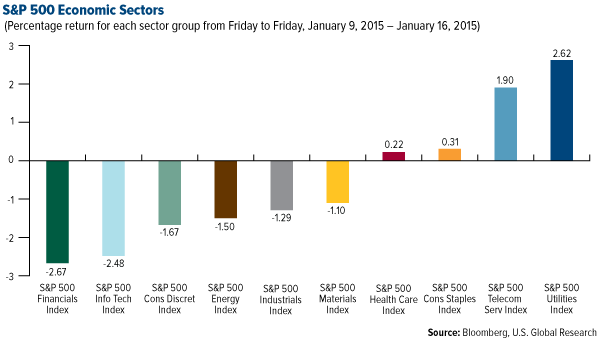
click to enlarge
Strengths
- Utility stocks resumed leadership this week as bond yields dropped and defensive areas outperformed. It was a broad-based macro-driven rally for the entire sector.
- The telecommunication services sector was also a beneficiary of a weak market in which defensive non-cyclicals outperformed.
- was the best performing company this week rising 12.64 percent. The company reaffirmed its earnings forecast for the fourth quarter and full-year 2015 reassuring investors.
Weaknesses
- The financial sector was the worst performer this week as Citigroup JP Morgan and all disappointed the market with earnings.
- The technology sector also underperformed this week as data-storage chip makers came under pressure after reported preliminary quarterly revenue that was below expectations. This news also dragged down and . was among the worst performers this week as well falling by more than 5 percent in what appeared to be general market skittishness.
- The worst performing company this week was which fell 18.67 percent. The company reported preliminary quarterly revenue that was below expectations as mentioned above driven specifically by weakness in mobile data-storage memory chips for tablets and smartphones.
Opportunities
- After outperforming in 2014 defensive stocks may be poised to continue that outperformance. The appears intent on normalizing monetary policy and the bond market is responding by sending long-term yields lower. This implies that the market believes a tighter Fed policy will materially slow the economy.
- Earnings season will kick into high gear next week with some key companies to watch including and .
- If oil can find a bottom and move higher small and mid-cap energy stocks would be among the first beneficiaries.
Threats
- The rally in U.S. energy producers may be short lived as OPEC countries seem to be acting individually rather than as a collective cartel making predictions of future actions more difficult. This could be positive however for the inverse-beneficiary companies in sectors such as airlines and consumer discretionary.
- The European Central Bank (ECB) is widely expected to announce a substantial quantitative easing (QE) program next week. If the ECB fails to follow through in meeting these lofty expectations the market could sell off.
- Earnings season got off to a rough start this week with large-cap financials disappointing and the market reacting accordingly. If the market is looking for an excuse after such steady performance over the past year a lackluster earnings season may be the catalyst for that 10-percent correction it’s been bracing for but that has not materialized for more than two years now.
Legal Disclaimer:
MENAFN provides the information “as is” without warranty of any kind. We do not accept any responsibility or liability for the accuracy, content, images, videos, licenses, completeness, legality, or reliability of the information contained in this article. If you have any complaints or copyright issues related to this article, kindly contact the provider above.